During my visit to San Diego this past Mother’s Day, Ba Ngoai taught me how to make pho bo from scratch. It was a two day affair, one day dedicated to purchasing groceries and another to preparing the soup. Shopping and cooking on the same day is an exhausting endeavor for a senior citizen, so I was happy to divide the tasks in order to finally conquer Vietnam’s most iconic noodle soup.
The leg bones that we had procured the day before were soaking on the stove when I arrived at her house on Sunday afternoon. She switched the flame on high soon after, parboiling the limbs to get rid of impurities. Next, she instructed me to turn off the heat, grab ahold of the pot, and follow her into the backyard. I wasn’t sure what was going on, but what Grandma says goes in my family.
In the backyard, we dumped the scummy water into a ditch of sorts that my grandfather had constructed for this very purpose, making sure not to lose any bones in the process. We then squatted Saigon-style, turned on the garden hose, and rinsed each nub under cold water. It seems that Grandma has a fear of clogging up the kitchen sink, hence this unorthodox, old world technique. After the bones had been thoroughly cleaned, we brought them inside the kitchen and proceeded to make the broth.
When it came time to char the ginger and onion, ingredients essential for perfuming and coloring the soup, Grandma reached into her bag of tricks once more and employed a beat up tin can that was once filled with bamboo shoots. The can’s tight and intensely hot compartment yielded an evenly charred onion with neither fuss nor mess. Grandma’s kitchen genius knows no bounds.
The recipe that follows for my grandmother’s pho bo has been adjusted ever-so-slightly to reflect the sensibilities of modern cooks like myself. While I’d love to have a drainage ditch dedicated to soup scum in my backyard, our current one-bedroom in Pasadena doesn’t allow for such luxuries. Additionally, I’ve swapped out the tin can for a flame-licked grill in order to char the aromatics. While I finessed some of Grandma’s cooking techniques, the soul and flavor of her pho hasn’t been fiddled with one bit. After all, perfection shouldn’t be messed with.
I had an incredible afternoon shadowing Grandma and learning how to construct a well-balanced and deeply satisfying pho. I hope you can taste the love.
For broth
- 5 pounds beef bones with marrow (leg bones, oxtails, etc.)
- 4-5 ounces fresh ginger root
- 1 onion
- 1 daikon, peeled, trimmed, and cut in half or thirds
- 5 star anise
- 8 cloves
- 2 3-inch long cinnamon sticks
- 1 teaspoon cumin seeds
- 5 tablespoons salt, divided
- 4 tablespoons fish sauce
- 4 tablespoon sugar, divided
- 1/2 tablespoon monosodium glutamate (optional)
For toppings and garnish
- 2 pounds beef plate
- 1 pound beef tripe
- 2 pounds beef top round or eye round, sliced thinly
- 1/2 bunch cilantro, chopped
- 1/2 bunch scallions, chopped
- 1/2 onion, thinly sliced
- Fresh herbs such as Thai basil, Vietnamese coriander, etc.
- Limes, cut into wedges
- Fresh beansprouts, trimmed
- Hoisin sauce
- Chili sauce
For noodles
- 2 to 3 pounds “rice stick,” prepared according to directions on package
Make broth
Dry roast the star anise, cumin seeds, cloves, and cinnamon sticks in a non-stick skillet over medium heat until fragrant. Set aside to cool.
Once the spices have cooled, transfer to a muslin spice sachet and tie the bag closed tightly.
Heat a barbecue grill or char gill pan over high heat and grill the unpeeled onions and ginger evenly until all sides are blackened, approximately 45 minutes.
While the onion and ginger are blackening on the grill, begin preparing the stock. If time permits, submerge the bones in cold water and soak for 1 hour, then drain.
Otherwise, place the bones in a large stockpot. Fill the stockpot with enough water to cover the surface of the bones and bring to a boil. The bones will have some impurities that need to be washed away, so once the water has boiled for 2-3 minuets, discard it and collect the bones in a colander. One by one, rinse the bones to remove any scum. The cleaner the bones are, the clearer the broth will be.
After giving the stockpot a thorough cleaning, fill it with 8 quarts of water and bring to a boil along with the bones, daikon, beef plate, and 2 tablespoons of salt. Skim the foam and fat off the surface as needed using a fine mesh skimmer.
Place the onion and ginger into the broth after they have been properly charred—give the ginger a few good whacks with the side of a cleaver to split it first. Add in 3 tablespoons of sugar, as well as the spice sachet.
Next, lower the heat to medium-low and bring all of the ingredients to a gentle simmer (such that you see a few small bubbles breaking the surface every few seconds) and cook for 3 to 4 hours, skimming off any fat or foam that rises to the surface. If the broth reduces too much, add additional water.
When the beef plate is tender (after 3-4 hours), remove it from the broth and submerge it in a bowl of cold water for five minutes. This will keep the meat from discoloring.
Finally, season the broth with the remaining salt, fish sauce, sugar, and monosodium glutamate if using. The broth should taste just a touch saltier than one would expect to desire because the noodles and garnishes aren’t seasoned for the most part.
Make toppings and garnish
Drain the beef plate and slice it in 1/4″ thick slices. Set aside.
For the tripe, bring water to a boil in a medium-sized sauce pan. Add the tripe to the boiling water and bring to another boil, approximately 4 minutes. Drain the tripe and run under cold water. Slice thinly and set aside.
Combine the scallions, cilantro, and onions and set aside.
Assemble Pho Bo
Place a portion of noodles in each soup bowl and garnish with tripe and slices of the cooked beef plate and thinly sliced raw beef. Ladle the hot stock over the noodles and beef just before serving.
Garnish with the onion and cilantro mixture and a pinch of black pepper. At the table, add in bean sprouts, herbs, and a squeeze of lime. Dip the meats in hoisin and chili sauces for extra pow.
Makes approximately 12 servings.
[For Printable Recipe Click Here]
More Vietnamese noodle soup recipes from my family to yours:

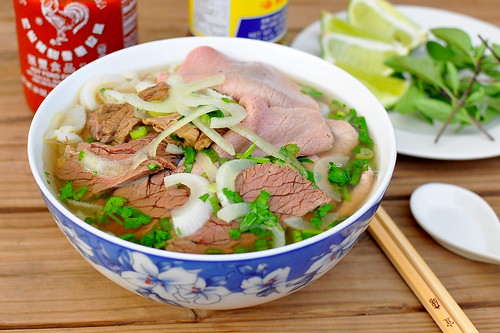
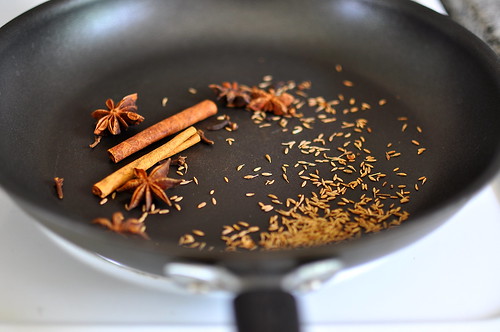
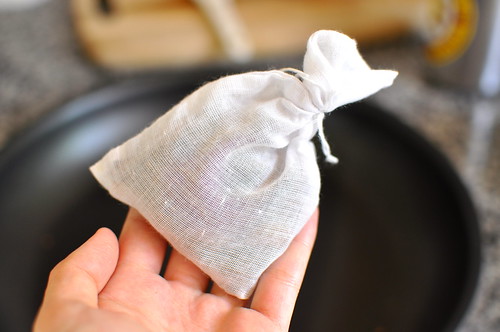
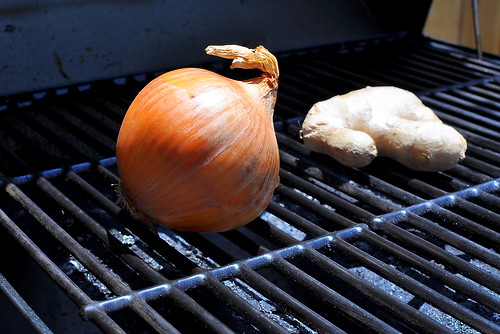
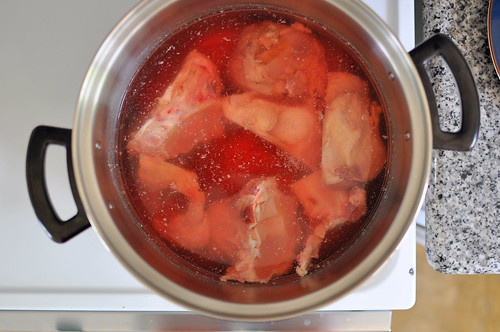
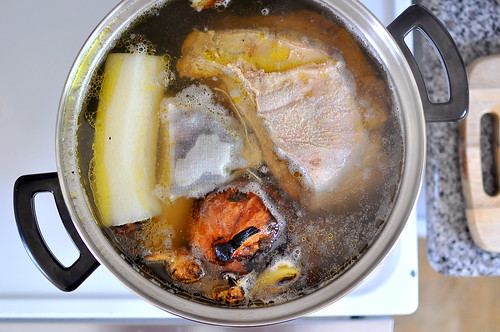
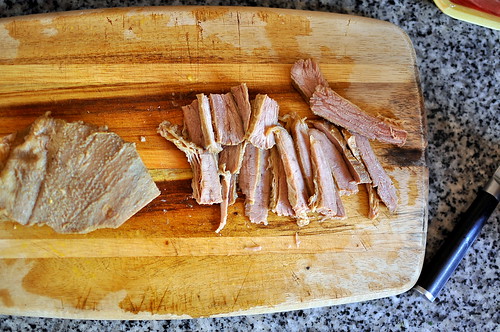
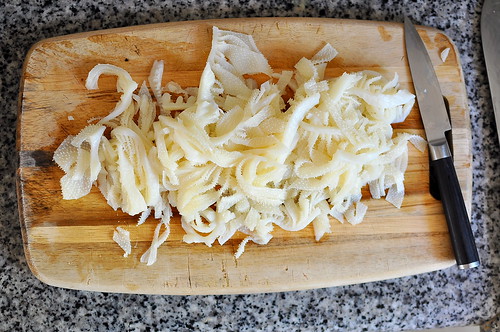
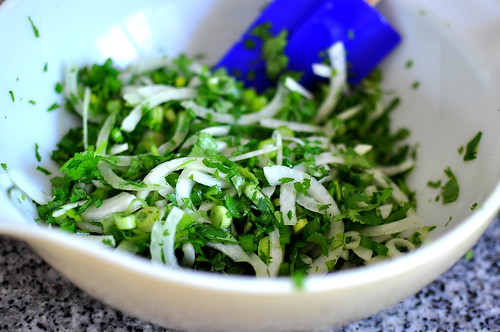

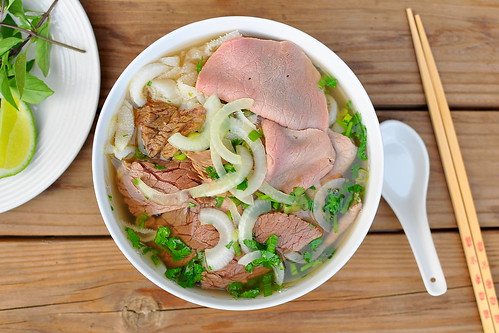
I loveeeee Phở (Bò) , but if I made it myself, I think I would die. I’m still a baby about handling tripe. I would have to make some other variety of Phở and work my way up to tripe.
As I sit halfway across the world from her, how I yearn for a bowl of my mother’s pho.
Nice recipe! I really wanted to see the MacGyver’d tin can setup but the link doesn’t work.
Just woke up to this… now I know what to get for lunch 🙂
Love this post…I’ll have to try to make this sometime soon.
This may be my favorite post of yours ever. Such a cool experience to see how pho is made for real and then getting to do it yourself.
your grandma used ajino moto for seasoning. That’s a no-no for me since i am allergic to that stuff. A nice trick that i learn is that if you leave your broth pot in the fridge over night, you could skim off all the congeal fat on top of the broth pot for a healthier version.
Jordan – Maybe eliminate the tripe and beef plate for your first pho attempt and stick to rare meat? They’re tasty bits, but not totally necessary for your first go round. Best of luck!
Famished Cowboy – Sorry about that! The link should work perfectly now.
Esi – THANK YOU!
Duy – A shame you’re allergic to MSG. It makes everything MMMM So Good 😉 And yes, a healthier broth can be had the next day upon chilling the soup. I’ve also found that skimming the soup every step of the way takes a good bit of the fat out in case one cannot stand to wait for pho.
Thanks for the great post, Cathy! Do you have any recs for the addition of tendon and beef balls? Can’t wait to try this recipe
What a lovely post! Pho would have to be my favourite noodle soup, followed closely by a Vietnamese chicken noodle soup. It’s great to learn these dishes from your family, isn’t it?
I also think it is interesting that you listed MSG in your ingredients – I’m pretty sure most Vietnamese families use MSG in their cooking and you can certainly notice its absence in some dishes. So I’m glad that you did because I am actually suspicious of Pho recipes without MSG! 😉
Despite the warm weather at the moment, I would love to sit down to a bowl of Pho right now. Your photos have me salivating!
mmmmm… yes please (w/ rooster sauce)
Will – To add beef balls (bo vien) to your pho, purchase fresh ones from the meat counter or frozen ones from the freezer section. For the fresh ones, add directly to the pho broth (either in the big mother pot or in a smaller pot if you’re reheating). As for the tendon, the leg bones have a good amount around the joints—scrape off with a knife or gnaw off the bone!
Thanh – Even though MSG gets a bad rap outside the motherland, I insist on adding it to every Vietnamese dish because of tradition. If it’s good ’nuff for Grandma, it’s good ’nuff for me 🙂
This looks so good….!!!!!!!!!!!
The dude and I thank you and your grandma for sharing this recipe. Mmm, delicious. 🙂
Congrats for conquering this, it looks great :). I’ve been around the whole cooking process way too many times to have NOT conquered this yet.
But GEEZ that tin can onion trick is MONEY! I must keep that in my toolbox.
I will have to try the recipe again, because I forgot to add daikon to the broth. I am not sure if the daikon will reduce the aroma of cumin seed, but my son and my wife does not like the aroma that common in the Indian dishes.
Cathy,
Thanks for sharing this recipe. I ran across this on Pinterest and thought wait… I know this person. My dear friend, glad to see you are doing well. Do you have a way to make this vegan or vegetarian?
Alivia
I’m glad to see that you’ve include MSG in your recipe. I’ve tried making it many times in many variations without it and NO, it doesn’t taste like how it SHOULD taste. Sorry to say that authentic tasty pho needs powder sugar (direct translation). I call it the Vietnamese cocaine for cooking.
Sorry…direction translation for MSG is sweet powder.
I love that you use MSG in your recipe. I notice a lot of Vietnamese people tend to shy away from it since all the MSG bashing. I’m sure there are people allergic to it, just like there are people deathly allergic to peanuts (which can be even more dangerous as you can go into anaphylactic shock and die from nut allergies). However, the bias against MSG isn’t warranted based upon what I’ve read in the past. Generations of Asians (billions of us) have cooked with it for decades and now all of a sudden, it’s toxic? Uh, no. It’s still used in Western snacks and such, but now they may hide it under the guise “natural flavoring” or whatever. Which it is. Natural. From what I recall, it occurs in mushrooms and such. Anyway, I’m big on how things are made traditionally because I’m interested in how things were made in their pure form before modern peeps alter it. Everyone is free to modify the recipes to their own taste and allergies, but we should all know how something was made originally first. Thanks for a great site!
Looks fantastic! Can’t wait to give it a shot. There seems to be a bit of contradiction between the ingredients list and the instructions, though… Does your grandma use cumin seeds, or anise seeds, or both, in her spice mix?
Chris – Thanks for catching that! I’ve amended the recipe to reflect cumin seeds.
How many servings does this make?
David – This makes 10-12 servings. Enjoy!
great recipe and i LOVED the photos. followed the instructions as printed (even used the tin can, lol), and it came out pretty damn good! first time making pho at home. i know that practice makes perfect, so i’ll be returning to this recipe several times. yum!
Thanks for the report, caliqueen! Love hearing how recipes worked out 🙂